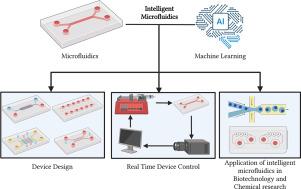Synergizing microfluidics and machine learning for next generation intelligent Lab-on-a-Chip devices
IF 4.9
2区 化学
Q1 CHEMISTRY, ANALYTICAL
引用次数: 0
Abstract
This review explores the synergistic integration of microfluidics and machine learning, highlighting their combined potential to transform conventional Lab-on-a-Chip systems into state-of-the-art intelligent and autonomous platforms. In brief, the paper highlights the importance of this synergistic approach and potential research avenues in which this technology will be beneficial. Different methods of data collection to build a machine learning model are discussed briefly. Then the paper discusses the use of machine learning in microfluidic device design and highlights automatic tools like Design Automation of Fluid Dynamics for droplet diameter prediction and flow sculpting via convolutional neural networks. The paper recounts machine learning driven control strategies for real-time flow behavior and droplet size manipulation, employing reinforcement learning, Bayesian optimization, and convolutional neural network-based feedback systems. The article further explains the varied applications of intelligent microfluidics in biotechnology, such as cell sorting, cytometry, and disease diagnostics which uses classical machine learning models and deep learning. In chemistry-related research, machine learning aids in optimizing reactions and predicting concentrations, while in biosensing, it enables enhanced signal processing and biomarker detection. Finally, the article also covers the growing impact of machine learning in organ- and organoid-on-chip platforms, and emphasizes their combined role in personalized medicine and disease modeling. Collectively, these advancements underscore the pivotal role of machine learning in enhancing microfluidic functionality, scalability, and clinical relevance, and fosters mutually beneficial relations between the two emerging fields.

为下一代智能芯片实验室设备协同微流体和机器学习
这篇综述探讨了微流体和机器学习的协同集成,强调了它们将传统的芯片实验室系统转变为最先进的智能和自主平台的综合潜力。简而言之,本文强调了这种协同方法的重要性和这项技术将有益的潜在研究途径。简要讨论了建立机器学习模型的不同数据收集方法。然后讨论了机器学习在微流控装置设计中的应用,并重点介绍了通过卷积神经网络进行液滴直径预测和流动雕刻的流体动力学设计自动化等自动化工具。本文叙述了机器学习驱动的实时流动行为和液滴大小操纵控制策略,采用强化学习,贝叶斯优化和基于卷积神经网络的反馈系统。本文进一步解释了智能微流体在生物技术中的各种应用,例如使用经典机器学习模型和深度学习的细胞分选,细胞术和疾病诊断。在化学相关研究中,机器学习有助于优化反应和预测浓度,而在生物传感中,它可以增强信号处理和生物标志物检测。最后,文章还涵盖了机器学习在器官和类器官芯片平台上日益增长的影响,并强调了它们在个性化医学和疾病建模中的综合作用。总的来说,这些进步强调了机器学习在增强微流控功能、可扩展性和临床相关性方面的关键作用,并促进了两个新兴领域之间的互利关系。
本文章由计算机程序翻译,如有差异,请以英文原文为准。
求助全文
约1分钟内获得全文
求助全文
来源期刊

Microchemical Journal
化学-分析化学
CiteScore
8.70
自引率
8.30%
发文量
1131
审稿时长
1.9 months
期刊介绍:
The Microchemical Journal is a peer reviewed journal devoted to all aspects and phases of analytical chemistry and chemical analysis. The Microchemical Journal publishes articles which are at the forefront of modern analytical chemistry and cover innovations in the techniques to the finest possible limits. This includes fundamental aspects, instrumentation, new developments, innovative and novel methods and applications including environmental and clinical field.
Traditional classical analytical methods such as spectrophotometry and titrimetry as well as established instrumentation methods such as flame and graphite furnace atomic absorption spectrometry, gas chromatography, and modified glassy or carbon electrode electrochemical methods will be considered, provided they show significant improvements and novelty compared to the established methods.
 求助内容:
求助内容: 应助结果提醒方式:
应助结果提醒方式:


